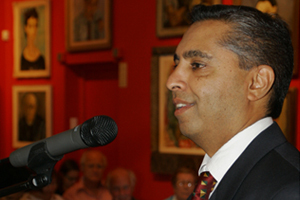TB still outfoxing the human race after millennia
24 March 2014 | Story by Newsroom
One of the leading causes of death in Africa, tuberculosis, or TB as it is commonly known, has received a great deal of media interest recently, charting the development of new treatments, and highlighting new methods of diagnosis.
The challenge around the diagnosis of TB was the subject of a recent Café Scientifique* talk presented by Professor Keertan Dheda, Director of the Lung Infection amp; Immunity Unit and the UCT Lung Institute, and Head of UCT's Division of Pulmonology.
According to Dheda a key impasse to TB control is the lack of an accurate, affordable point-of-care diagnostic for the disease.
"TB is a major problem in South Africa and we treat almost half a million cases a year. South Africa has the dubious distinction of having the highest TB incidence in the world."
"It is the most common cause of death in the country and is estimated to reduce our gross domestic product by 5% or around R14 billion," explained Dheda, sketching the context within which he and his team have to operate in their search for new and more accurate ways to diagnose TB.
Many factors bedevil the development of an accurate TB diagnostic. Firstly, there are different types of TB '“ active TB manifests in those who are sick, and latent TB (sleeping TB) is present in almost half of South Africans who may have no symptoms. The tubercle bacillus and many of its relatives have co-evolved with humans over thousands of years, and thus, unlike in other diseases, antibody and other immmune responses fail to dintinguish between active TB, latent TB, previous exposure and exposure to harmless environmental cousins of the tubercle bacillus.
Getting a sputum sample is also a challenge. Many TB sufferers are also HIV-infected and these patients either don't produce sputum, or produce sputum with a very low concentration of bacteria.
"There is also extra-pulmonary TB, which can affect the brain, the lining of the lungs, the heart, etc," Dheda added.
Getting a sputum sample from such patients will often not help since the disease is anywhere but the lungs. In up to 30 to 40% of TB patients in South Africa the disease cannot be diagnosed using a sputum sample," said Dheda.
Neither is the disease easily diagnosed using X-rays because pneumonia and other inflammatory lung diseases may look like TB on X-ray. "And because HIV is so prevalent in South Africa, the typical X-ray appearance of TB is no longer typical," he noted.
There is hope at the end of the TB tunnel. Dheda and his team received a grant from the Medical Research Council (MRC) to develop an ultra-sensitive lateral flow assay '“ which operates on the same principles as a home pregnancy test.
To develop such a TB test, a TB specific bio-marker is needed and Dheda and his inter-disciplinary collaborators at UCT have found five to six new TB specific bio-markers, which they hope to exploit using the MRC funding.
*Café Scientifique is presented by UCT's Research Contracts and Intellectual Property Services. Funded by the Technology Innovation Agency, the talks aim to bring science to the broader community through a series of engaging dialogues.
To view more about TB research at UCT please watch UCT Lancet TB diagnostics.
Story by Abigail Calata. Image supplied.
 This work is licensed under a Creative Commons Attribution-NoDerivatives 4.0 International License.
This work is licensed under a Creative Commons Attribution-NoDerivatives 4.0 International License.
Please view the republishing articles page for more information.










